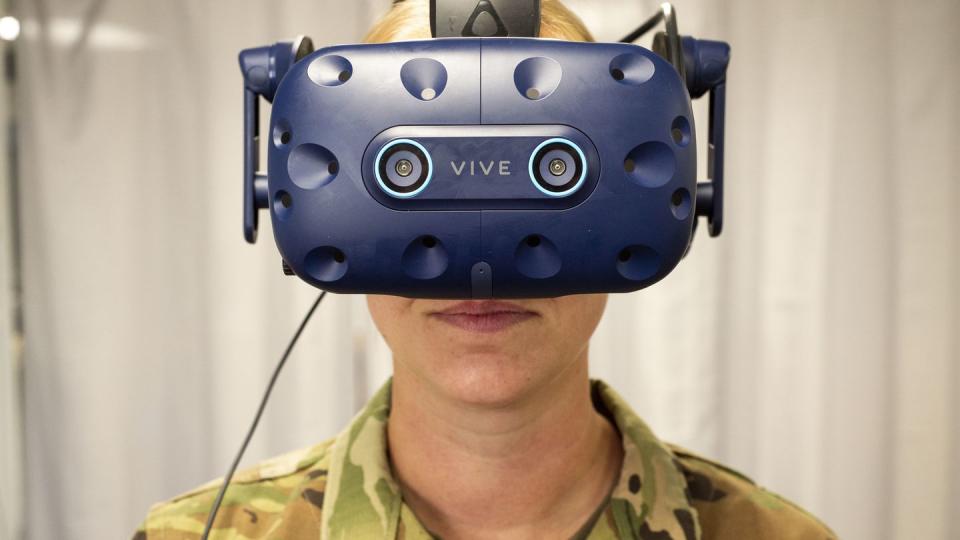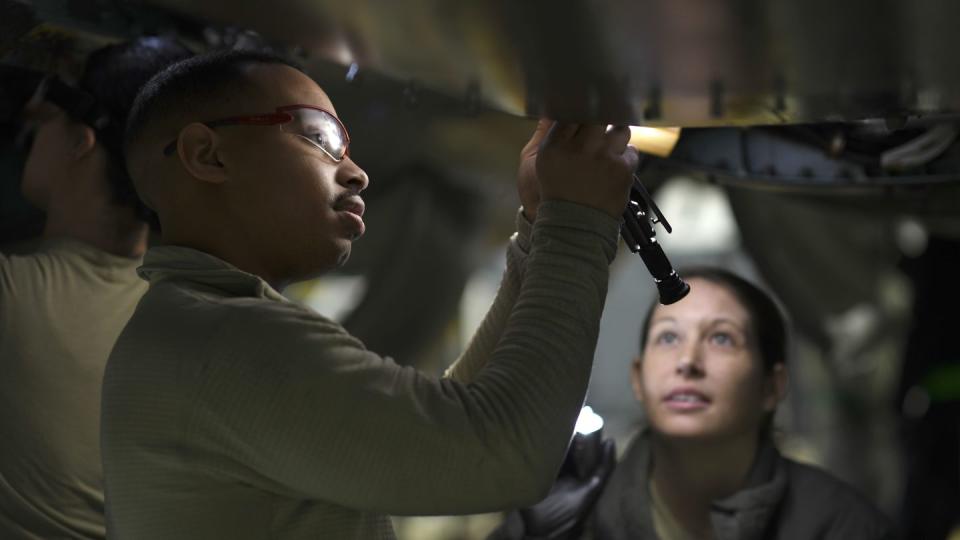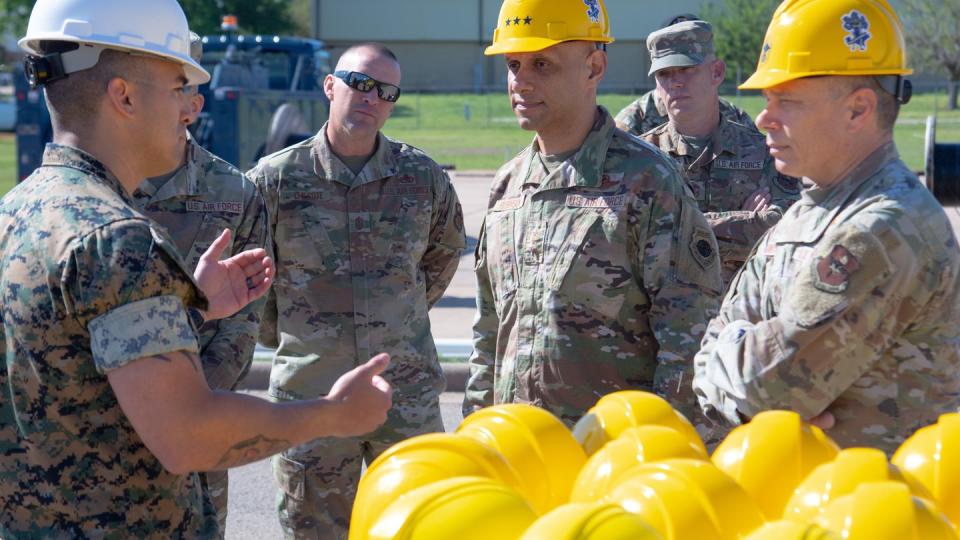The Air Force reimagines its tech schools
JOINT BASE SAN ANTONIO-LACKLAND, Texas — Nearly eight decades after the Air Force’s founding, the schools that prepare airmen for their military jobs are due for an overhaul.
Air Education and Training Command wants to modernize its technical training enterprise for the 150,000 airmen who take courses across more than 100 specialties each year. That requires a new look at everything from what students should be learning and how, and the environment in which they learn it, the three-star general in charge argues.
When airmen join the military, they take a step back to a learning environment of decades past, AETC Commander Lt. Gen. Brian Robinson said in a recent interview at the organization’s headquarters here.
Virtual training yields real results in early crew chief course
“Most of the airmen who join the Air Force today have come up … through high school and [middle school], using technology in a way that we don’t in the Air Force,” he said.
It’s more than a lack of iPads: It’s training mechanics on engines that look nothing like those they’ll see on the job. It’s holding classes in workshops without enough outlets to power the tech they do have. And it’s piles and piles of paper manuals.
Most technical training is run out of four installations: JB San Antonio, Goodfellow Air Force Base and Sheppard AFB, Texas; and Keesler AFB, Mississippi. Courses can last anywhere from six weeks to a year and a half, depending on the specialty.
Tech school is typically an airman’s first introduction to a career field, and also provides their transition between boot camp and everyday life in an Air Force unit. But the gap between those classrooms and the real world is getting wider.
Robinson wants to digitize tech school curriculum, with on-demand content that students can pull up anytime. He’d like to expand the use of virtual reality, which gives airmen more access to planes and other equipment than they might get in real life. And he hopes to make classrooms and dormitories more collaborative, Internet-connected spaces.
As Air Force revamps pilot training, flight safety concerns linger
The changes would mirror years of work at basic military training and undergraduate pilot courses to move faster, adopt new technology and adapt to the modern ways of war.
“We’re pretty confident that’ll allow them to become qualified in the skill sets [and] competencies they have to be qualified in … at equal or better levels — and faster,” Robinson said.
Years of revamping pilot training has taught the Air Force how to “design a syllabus with the end in mind,” Robinson said.

That aims to build student comprehension rather than checking boxes as they move through the material. Teachers would be facilitators, not lecturers.
The approach Robinson envisions can also be cheaper than ordering advanced simulators that cost millions of dollars and doesn’t take operational jets and other assets away from their daily missions. And, he added, speedier training could also help replace airmen who are killed in combat, if an intense shooting war breaks out.
Allowing students to learn and interact via tablets, phones and laptops is particularly important for a generation that spent much of the past few years in distance learning.
“You definitely do see a difference from airmen from pre-COVID, to airmen that went to high school during COVID and then joined the military, and now we’re expecting them to be good at interacting with their peers,” said Tech. Sgt. Clarissa Scott, a military training leader with the 344th Training Squadron. “We are definitely meeting them where they’re at with technology, and giving them the space to, one, make mistakes, but then also learn from those mistakes.”
Air Force hopes tablets could revolutionize basic training
Airmen in the “Fundamentals of Aircraft Maintenance” course at Sheppard told Air Force Times that the class — which uses videos and VR for about three-quarters of its lessons since first piloting the idea in 2020 — has helped them study more thoroughly, efficiently and collaboratively.
Students can rewatch videos at home until they understand the material, or pull apart a virtual engine inside a VR headset. The reinforcement those tools provide can make the difference between passing or failing. And it’s easier to update that software to evolve with the times.
“There’s a lot of information inside the old paper booklets that … wasn’t pertinent to what was actually being tested,” Airman 1st Class Ray Gonzalez said. “Having the tablets that are actually slides, verbatim, of what the instructor is showing really helped to focus actually on what was needed.”
Other courses are gamifying their lessons to encourage more interaction between students and forcing them to think through real-world planning. Instead of listening to a lecture, airmen can move their desks to work in groups and better understand what airmen in other fields need.
First Lt. Kimberly Espinoza, a munitions maintenance officer from Japan’s Kadena Air Base, has seen that difference firsthand. She spoke to Air Force Times during a course at Sheppard that brings together aircraft and munitions maintainers to game out logistical scenarios they may face, leaving students feeling better prepared.
“When I came here in the past for tech school, a lot of it was … ‘death by PowerPoint,’” she said. “Here … we’ll have a lesson and, immediately after the lesson, go into an exercise of, ‘OK, how do you use this in your units?’”
Virtual reality training for pilots, maintainers and more expands in 2020
![Airman Tyler Mckenna, a 361st Training Squadron propulsion apprentice course student, safety wires an electric plug on an aircraft engine at Sheppard Air Force Base, Texas, in June ]2020. (Alan R. Quevy/Air Force)](https://s.yimg.com/ny/api/res/1.2/2U9PolxxBHwhwCuFDXZQqw--/YXBwaWQ9aGlnaGxhbmRlcjt3PTk2MDtoPTU0MA--/https://media.zenfs.com/en/air_force_times_767/224744b69cb7d7c70df881204df7db4f)
The path forward
Robinson declined to say what an overall timeline might be for bringing tech schools into the 21st century, or its benchmarks for determining success. Over the next 18 months, he wants to lay out the basic skills that airmen in each career field must learn. Changes focused on those competencies will follow.
The goal is to deliver newly trained airmen to their first operational bases with as many of those skills as possible.
Robinson suggested AETC will first tackle updates for maintainers, followed by firefighters and intelligence, surveillance and reconnaissance specialists. Second Air Force, the subordinate organization in charge of basic and technical training, will set those priorities, he said.
Turning toward technological solutions can create another problem: finding qualified simulator instructors to run them. Robinson hopes to turn to remote teaching staff who can run that software from anywhere in the world.
He estimates that tech schools have about 80% of the staff they need. He’d like to grow that to around 90%.
Col. Lauren Courchaine, head of the 37th Training Wing, which manages the training enterprise at Joint Base San Antonio, wants to give instructors the resources they need to thrive, and to return to their previous jobs better than they left them.
Some airmen are wary of becoming instructors because they fear falling behind in their professional skills and being passed over for promotion.
“The skills that they learn in this environment, in terms of leading such a diverse group of people across different [specialties], are the traits that I really hope we can implement into the Air Force as we look at what the next fight could be,” Courchaine said.
Can the Air Force train nearly 1,500 pilots this year?

Rethinking the ‘pipeline’
Improving tech school is key to reaching a broader goal: easing the transition between boot camp, technical training and an airman’s first operational base.
In September, staffers from Air Force Recruiting Command, basic training and technical training joined curriculum writers to explore how to stretch lessons across each phase, Courchaine said.
“Where I see the biggest breakdown is not necessarily in a Second Air Force pipeline, in terms of BMT or technical training, it’s that jump between technical training and the first base,” she said.
She envisions two things an airman should get at basic training and carry with them throughout their career. One is a piece of technology, like a tablet, to hold what they learn in school and the Air Force regulations and resources.
The other is their airmanship habits, from respectful interaction with their teammates to cyber hygiene online. Air Force instructors should show, not tell, students how to embody values like emotional resilience and open communication, Courchaine said.
Robinson also wants to improve at teaching airmen to think on their feet and make decisions on their own. That’s driven by the Air Force’s move toward more flexible combat deployments with smaller field teams than they might have at an established base.
Air Force ditches 'BEAST Week' for new mock deployment training
Those lessons start during boot camp and have begun to spill over into tech school, like emphasizing new ways of problem solving at the intelligence community’s schoolhouse at Goodfellow AFB, Robinson said.
And he has publicly mentioned the idea of getting away from a traditional training “pipeline” altogether.
Ideally, the Air Force could abandon the student cohorts that start and end at the same time, and let people graduate at their own pace. That gets complicated because of how military training is funded, and because operational units need a reliable flow of new airmen as others leave.
“We can actually get them to their first base quicker, which I think matters most to the airmen,” Robinson said. “You want them developing camaraderie, esprit de corps, and that sense of belonging … at their mission unit.”
To get there, the right infrastructure has to be in place: high-bandwidth, wireless Internet connections in classrooms and dorms, a strong electric grid with enough outlets, and workspaces that facilitate collaboration.

That helps accomplish more than homework. Without digital connectivity, airmen are cut off from the modes of bonding and relaxation they enjoy most.
Courchaine recalled meeting one airman with a Snapchat “streak” — the consecutive number of days that two users swap photos or videos on the app — over 3,500 days long. And she pointed to her own kids’ gaming habits.
“If you want to go play PlayStation 5 in your dorm room, you should be able to play PlayStation 5 in your dorm room,” she said. “That’s how they blow off steam and talk to all of their friends.”
Right now, leaders are focusing on curriculum more than culture. But updating tech school policies like its 10 p.m. curfew, or its visitor rules, could appeal to the current generation of airmen that now skews older than in the past.
Leaders said those areas are ripe for reconsideration, but that they have to maintain discipline among young airmen.
“Your frontal lobe is not fully developed — let me help you. But there’s also a piece where, yes, in my mind, you’re still in training,” Courchaine said. “Make dumb mistakes here instead.”

